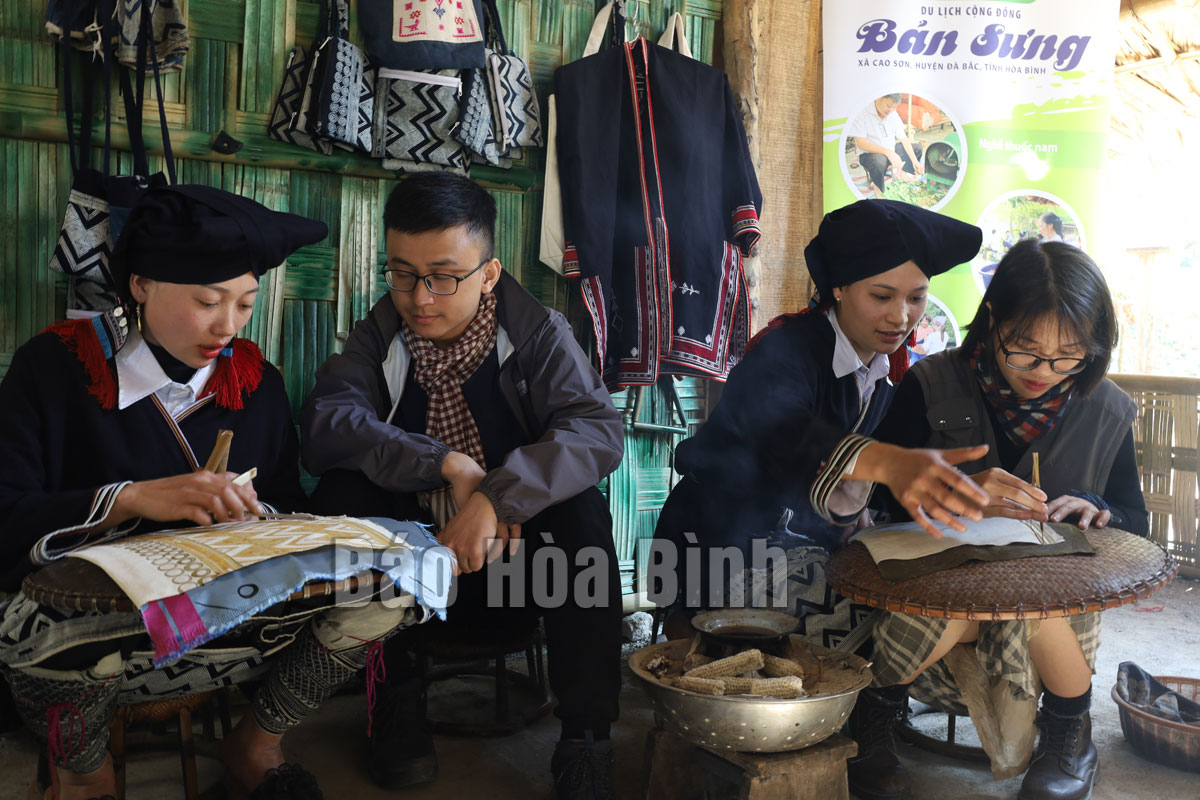



Visitors are experiencing beeswax printing and making brocade products in Sung village, Cao Son commune (Da Bac).
Mr. Ban Van Xuan, the Vice Chairman of the People's Committee of Cao Son Commune says: Covid -19 pandemics has affected and sharply reduced the flow of domestic and foreign tourists, as well it has caused many difficulties for the Dao Tien people in the Sung village. The tourism facilities of homestay households have been degraded, and the traditional handicrafts are gradually disappearing. However, with the attention of the local authorities and the support resources from the project "Improving the self-sustainability of the community tourism model in Sung village after Covid-19 pandemic”, the life of the people in the village have picked up the pace again, and the tourism activities have been quickly restored.
For the first time, Mr. Dinh Tu Minh Chau (Hanoi) has visited and experienced the village of Dao Tien people. A two-day stay here gives him a deep impression of a village that seems to be isolated from the outside. Away from the hustle and bustle of the city, Mr. Chau can experience the forest landscape that retains its wild beauty, the unique cultural features of Dao people that still exist through the traditional houses, the way of wearing costumes, and the spoken language, the customs and habits.
For Ms. Nguyen Thuy Tien, a companion with Mr. Dinh Tu Minh Chau, Sung village has many new and interesting things that hit the psychology and discovery needs of tourists. The first thing is to breathe the fresh air and blend into the daily life of the people. Next thing is to visit many places, experience the work of dyeing indigo, printing beeswax and making brocade and Do paper products; experiencing, soaking, bathing with the medicinal leaves of Dao people…
According to Ms. Dinh Thi Hao, the Director of Da Bac Community Tourism joint Stock Company, the recovery of the traditional occupations and the indigenous values has promoted community tourism in Sung village after Covid-19 pandemics. Especially, Sung village is becoming a colorful experience point, a sustainable community tourism model with a wide range of products and services, and the love of domestic and foreign tourists for the destination has been maintained. In recent months, a lot of international and domestic delegations have returned to Sung village, the number of visitors has been stable. Through the strategy of communication, promotion and connection with travel companies, Da Bac Community Tourims joint Stock Company has actively attracted guests to support homestay households in the village.
Previously, the Sung village mainly welcomed international visitors, now the number of domestic visitors has been increasing. At this unique stop, there are 3 homestays including Nhat Quy, Xuan Lan and Thanh Chung, which welcome guests and provide services. A number of tour programs are of interest to visitors, including tour to discover the ancient Doi tree, the palm forest, Sung cave, tea picking, stream bathing, experiencing writing Dao script and visiting Shan Tuyet tea production team; the tour to the class teaching Dao language, Sung cave, stream bathing, visiting the terraced fields, picking herbal medicines, dyeing indigo and making brocade products...Visitors also have the opportunity to learn and discover new features of tourism products and services in the village. They include visiting a pharmaceutical factory under a closed process, a solar medicine drying house; experiencing beeswax printing, indigo dyeing, making Do paper with the guidance of the local people. In addition, visitors can buy souvenir products as gifts such as bags, keychain wallets, brocade woven cup pads or items made by the local people. They are Shan Tuyet tea, Dao Co Lam tea, herbal bath leaves, herbal mosquito spray, red ginger massage alcohol... which have more diverse designs and types with low prices, and they are suitable for tastes and ability to pay.